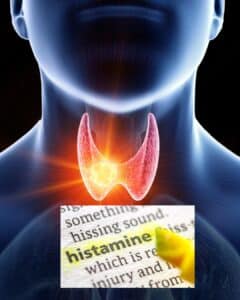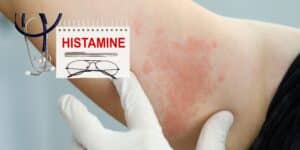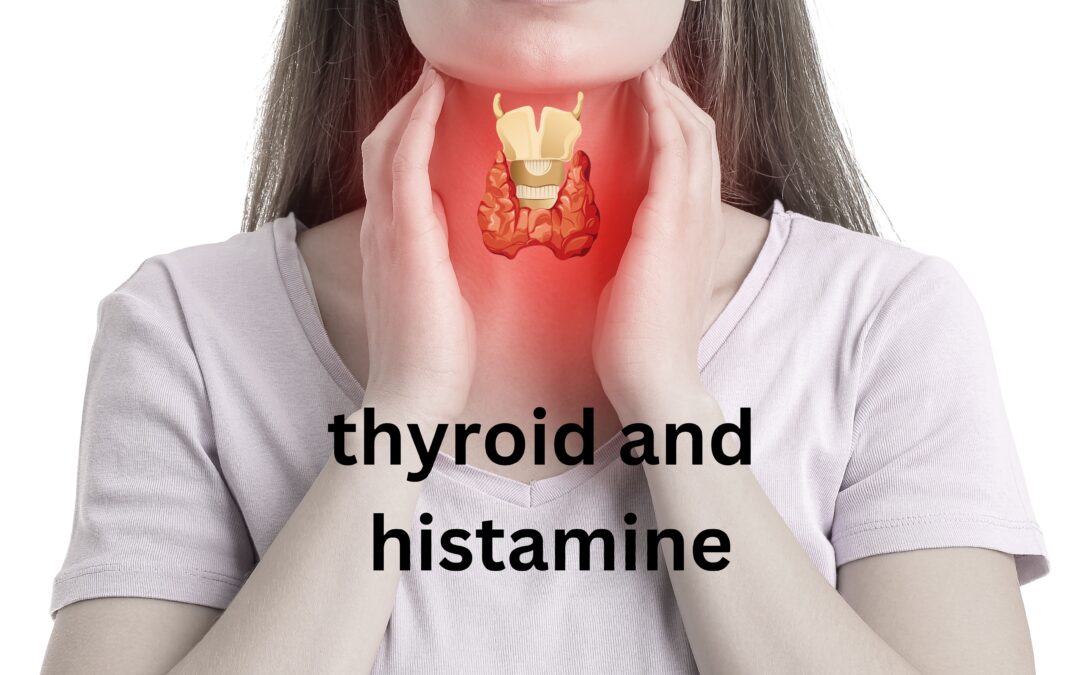Recently, I had a patient who experienced histamine reactions after starting a thyroid medication containing both T3 and T4. This reaction caught my attention because, while there’s a well-established connection between thyroid function and bladder health in the medical literature, I hadn’t fully considered how certain thyroid hormones might actually promote histamine release.
The relationship between the bladder and thyroid is complex. Studies have shown that thyroid dysfunction can lead to bladder issues like increased frequency, urgency, and even pain. For example, hypothyroidism has been linked to slower bladder emptying and increased risk of bladder dysfunction. However, in some cases, thyroid hormones like T3 and T4 can trigger histamine release, which can exacerbate these symptoms, especially in those with mast cell activation disorders or histamine intolerance.
Histamine in the bladder often feels like burning, itching, or a sharp, stinging pain. It’s a sensation many with interstitial cystitis or bladder pain syndrome are familiar with. But histamine doesn’t just affect the bladder—it can also cause a wide range of symptoms in other parts of the body, including skin rashes, itching, nasal congestion, sneezing, headaches, and even digestive issues like bloating or cramping.
Given my patient’s experience and the complex relationship between thyroid hormones and histamine, I decided to do a deep dive into this topic in this blog. We’ll explore how thyroid hormones influence histamine levels, how histamine reactions manifest in the bladder and other parts of the body, and what you can do to manage these symptoms. If you’re interested in learning more, be sure to check out the related podcast episode where I cover this in more detail (link provided).
Mast cells
Mast cells are immune cells found throughout the body, originating from blood stem cells. In the brain, these cells are found in small numbers, mainly near the meninges and blood vessels, where they help with detoxification, immune responses, and interactions with neurons. These cells can increase in number and activity when exposed to certain environmental factors, impacting brain function and behavior.
Research shows that mast cells are important for brain development, protection, and even processes like sexual maturation. Stabilizing these cells could be a potential strategy to protect the brain from damage caused by overactive neurons. Understanding how mast cells function is a major focus in neuroscience, as it could reveal how imbalances in pro-inflammatory and anti-inflammatory signals, many of which come from mast cells, influence behavior and neuron health. This knowledge could also lead to new drug targets. Mast cells also play similar roles when interacting with sensory neurons throughout the body.
A key characteristic of mast cells is their ability to release various substances, including histamine, upon activation. Histamine is stored in specialized granules within the cells and is released along with other signaling molecules. Interestingly, mast cells can produce and store hormones like thyroid-stimulating hormone (TSH) and the thyroid hormone T3. Studies suggest that T3 levels in mast cells increase when exposed to low amounts of histamine. Additionally, mast cells have T3 receptors, and their numbers tend to rise in conditions like hypothyroidism, indicating a connection between thyroid health and mast cell behavior.
Understanding these interactions could provide new insights into the roles of T3 metabolites and how they impact overall health.
Histamine and the Thyroid: Exploring the Connection
Histamine is a pro-inflammatory chemical that can be beneficial in small amounts but may cause issues when inflammation becomes chronic. Interestingly, histamine behaves differently in nerve tissues compared to other parts of the body. In non-nerve tissues, histamine released from mast cells, basophils, or enterochromaffin-like cells contributes to inflammation, pain, itching, and blood vessel dilation. It’s primarily broken down by the enzyme diamine oxidase (DAO), which produces hydrogen peroxide and activates various receptors.
In the central nervous system (CNS), histamine comes from two sources: histaminergic neurons and mast cells. In the brain, histamine is not classified as a polyamine, and the enzyme DAO is absent. Instead, histamine is broken down by histamine methyl-transferase and monoamine oxidase B (MAO-B). Within the brain, histamine plays a key role in cell-to-cell communication, particularly between microglia and neurons. Medications that influence histamine release or stabilize mast cells can modulate the brain’s histamine system. Notably, mast cells have receptors for histamine, allowing histamine to regulate mast cell activity and contribute to local inflammation.
Histamine in the brain helps manage behaviors regulated by the hypothalamus and offers neuroprotection against damage. Additionally, it is involved in the protective effects of T3 (a thyroid hormone) metabolites on neurons. Histamine also plays a role in regulating the release of thyroid-stimulating hormone (TSH), linking it to overall thyroid function. Some studies suggest that histamine receptor blockers can impact T3 levels, further emphasizing histamine’s role in thyroid regulation.
T3 is essential for brain development and plasticity, affecting not only neurons but also glial cells. Glial cells, much like mast cells, possess T3 transporters. High levels of histamine are present during brain development in embryos, and research indicates that T3 might influence brain mast cell numbers and histamine levels.
In studies involving rats treated with L-thyroxine (a thyroid hormone), increased histamine levels were found in certain brain regions, which correlated with higher T3 and T4 levels. Interestingly, low concentrations of histamine have been shown to increase T3 content in mast cells, highlighting the intricate relationship between these systems.
Thyroid inflammation, also known as thyroiditis, often involves mast cell degranulation, which is crucial in its early stages. Mast cells and their histamine release are linked to the growth and spread of thyroid cancers by promoting tumor growth and the formation of new blood vessels. In fact, increased mast cell numbers in thyroid cancers, particularly in the follicular variant of papillary thyroid carcinoma, are sometimes used as a diagnostic marker.
Skin conditions such as chronic urticaria, alopecia, and atopic dermatitis often appear alongside thyroid diseases. Stress-induced mast cell activation connects the brain and skin in these conditions. The local release of T3 or its metabolites could influence these skin symptoms as well.
Interestingly, T3 has been detected in peritoneal mast cells, suggesting that these cells might distribute the hormone throughout the body. Activation of TSH receptors increases T3 content in mast cells, although the exact mechanism remains unclear. The idea that mast cells could act as an “alternative” thyroid gland is still a hypothesis, but it’s an area of ongoing research.

Thyroid Hormone Metabolites and Histamine: The Untapped Connection
Recent research suggests that when T3, a thyroid hormone, is metabolized, it produces compounds that can either mimic or counteract the effects of T3 without directly interacting with nuclear receptors. T3 undergoes metabolism through enzymes like decarboxylase, deiodinases, and monoamine oxidases (MAOs). These enzymes either work together or separately to produce three main categories of derivatives: thyronines, thyronamines, and thyroacetic or thyropropionic acids, each with different levels of iodination. MAOs transform thyronamines into thyroacetic acids, while deiodinases remove iodide ions without altering the compound’s core structure. Despite ongoing research, the exact pathways for synthesizing these metabolites remain unclear.
Both experimental and clinical studies indicate that T3 metabolites play a significant role in maintaining thyroid function and could be involved in thyroid-related diseases. Key metabolites under investigation include 3,5-diiodothyronine (3,5-T2), 3-iodothyronamine (T1AM), and 3-iodothyroacetic acid (TA1). These compounds have been found in both rodents and humans, and their distribution in tissues mirrors that of T3. Elevated T1AM levels have been observed in conditions like diabetes and heart failure, while increased 3,5-T2 levels have been associated with cirrhosis, brain tumors, and non-thyroidal illnesses. Additionally, higher 3,5-T2 levels have been linked to post-surgical atrial fibrillation.
What makes these T3 metabolites particularly interesting is their ability to cross the blood-brain barrier and replicate some of the effects of histamine. The presence of mast cells near the blood-brain barrier, along with histaminergic neurons, suggests that these cells could be targets for T3 metabolites.
Systemic itching is a well-known side effect of T3 supplementation, and hyperthyroidism is also associated with itching. T3 metabolites could be responsible for this reaction by triggering mast cell activation, leading to histamine release. This process can result in itching and increased sensitivity to pain. In fact, T1AM and TA1 have been shown to cause histamine-dependent hyperalgesia to heat, a response often linked to mast cell activation.
In summary, while the relationship between thyroid hormones and mast cells remains underexplored, it’s clear that T3 metabolites may play a crucial role in activating mast cells and triggering histamine release. This complex interaction offers a promising area for further clinical research, potentially revealing new insights into thyroid-related conditions and their impact on mast cell activity.

Do Thyroid Hormone Medications Release Histamine and Trigger Mast Cell Degranulation?
Thyroid hormone medications like levothyroxine (synthetic T4) and liothyronine (synthetic T3) are essential treatments for managing thyroid disorders such as hypothyroidism. However, for individuals with allergies, autoimmune conditions, or mast cell activation disorders, questions often arise about whether these medications could trigger histamine release or mast cell degranulation.
Understanding Histamine Release and Mast Cell Degranulation
Direct and Indirect Effects of Thyroid Hormones:
-
- Direct Effects:
- T3 and T4 Levels: Generally, thyroid hormones themselves do not directly cause histamine release or mast cell degranulation. However, there are reports that thyroid hormone levels can indirectly influence histamine production and mast cell behavior.
- T3 Metabolites: Some T3 metabolites, such as T1AM and TA1, are known to interact with the histaminergic system. These interactions can potentially activate mast cells, leading to histamine release.
- Indirect Effects:
-
- Allergic Reactions: In some cases, individuals may react to the inactive ingredients or fillers in thyroid medications, triggering an allergic response. This can cause mast cell degranulation and histamine release, leading to symptoms like itching, hives, or even anaphylaxis in severe cases.
- Autoimmune Conditions: For those with autoimmune thyroid disorders, such as Graves’ disease or Hashimoto’s thyroiditis, the relationship between the immune system and thyroid function is complex. Autoimmune activity can lead to inflammation, which may indirectly increase mast cell activation and histamine release.
Clinical Evidence Linking Thyroid Medications and Histamine Activity
Hypothyroidism and Histamine:
-
- Research suggests that hypothyroidism can result in increased mast cell numbers and higher histamine levels in tissues. By treating hypothyroidism with thyroid hormone medications, these levels may normalize, potentially reducing histamine-related symptoms.
-
- Note- Hyperthyroidism and Itching:
-
- Hyperthyroidism is sometimes associated with pruritus (itching), a symptom often linked to elevated histamine levels. Thyroid hormone medications can either alleviate or worsen these symptoms depending on the individual’s specific response to treatment.
Conclusion
While thyroid hormone medications like levothyroxine and liothyronine do not typically cause direct histamine release or mast cell degranulation, their overall impact on hormone balance and immune function can indirectly influence these processes. This is especially relevant for individuals with known allergies, autoimmune conditions, or mast cell activation disorders. Careful monitoring is recommended when starting or adjusting thyroid hormone treatments to watch for potential adverse reactions related to histamine and mast cell activity.
If you’ve been struggling with unexplained symptoms like bladder pain, itching, or constant nasal congestion that just won’t go away, and you suspect that your thyroid might be involved, it’s time to dig deeper. Histamine reactions, thyroid dysfunction, and mast cell issues are all connected in ways that are often overlooked in standard medical evaluations. That’s where my Root Cause Investigation comes in.
Through comprehensive testing and personalized analysis, we can uncover what’s really driving your symptoms—whether it’s a hidden thyroid imbalance, histamine intolerance, or something else entirely. Don’t settle for surface-level solutions. Let’s work together to get to the root of the problem so you can start feeling better and regain control of your health.
Ready to take the next step? Learn more about my Root Cause Investigation and how it can help you.
References
Landucci, E., et al. (2019). “Thyroid Hormone, Thyroid Hormone Metabolites and Mast Cells: A Less Explored Issue.” Front Cell Neurosci 13: 79.

